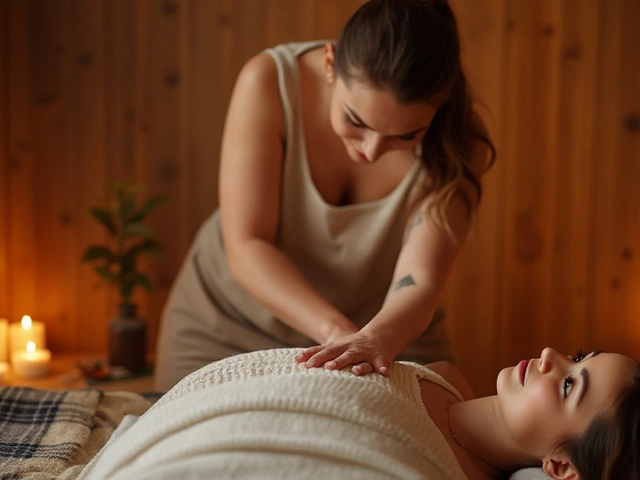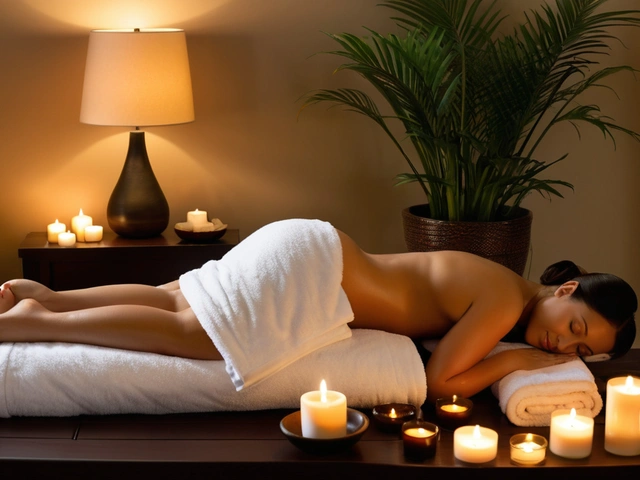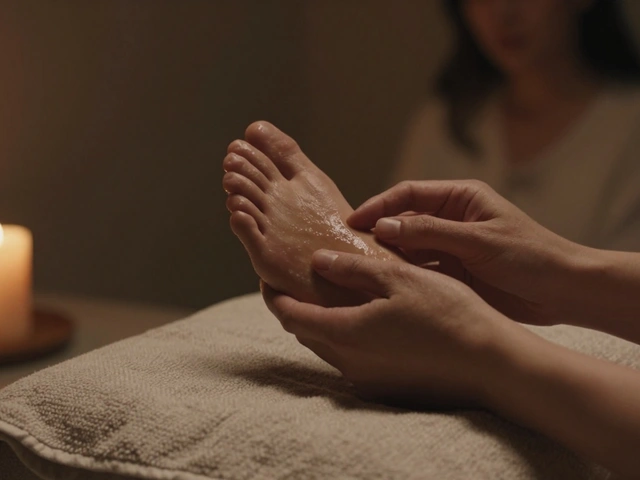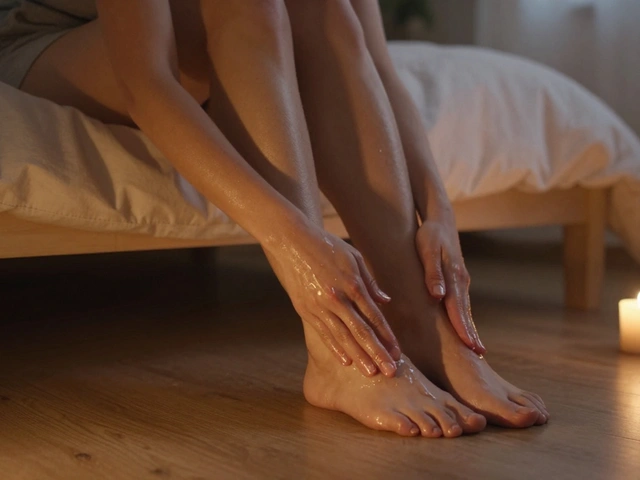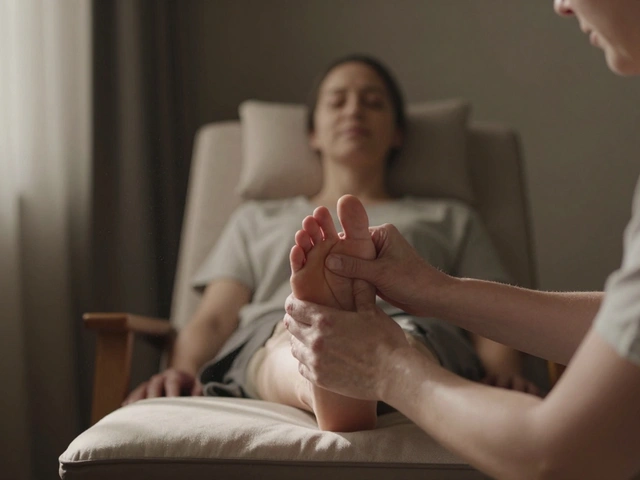Acu-Yoga Timer & Routine Guide
Sit cross-legged, close eyes, and breathe deeply:
- Inhale through nose for 4 counts
- Exhale for 6 counts
- Place right hand on left wrist
- Press LI4 point with left thumb for 30 seconds
- Switch hands and repeat
On all fours, flow between Cat and Cow poses:
- Inhale: Drop belly, look up (Cow)
- Exhale: Round spine (Cat)
- Apply light pressure to GV20 point on crown of head
Stand tall, hinge at hips:
- Let torso hang
- Press SP6 point on inner ankles
- Hold for 30 seconds each side
Step into Warrior II:
- Extend front arm forward
- Press Luohan point (thumb base) for 1 minute per side
- Switch sides
Sit and twist gently:
- Cross one leg over the other
- Apply pressure to ST36 point on outer knee
- Hold for 30 seconds per side
Return to seated position:
- Place hands on heart
- Inhale for 4 counts
- Exhale for 6 counts
- Feel calm settle in
Benefits of Regular Practice
- Reduces cortisol levels
- Activates parasympathetic nervous system
- Improves mindfulness and focus
- Enhances sleep quality
- Increases resilience to stress
Key Takeaways
- Acu-Yoga combines yoga poses, targeted acupressure and breath awareness to lower stress quickly.
- The practice balances the nervous system by reducing cortisol and activating the parasympathetic response.
- A 15‑minute routine can be done at home, at work, or in a quiet corner.
- Consistent sessions improve mindfulness, sleep quality, and overall resilience.
- It’s safe for most people, but those with severe injuries should adapt poses.
When you hear Acu-Yoga a hybrid practice that blends yoga postures with precise acupressure points to calm the nervous system, you might wonder if it’s another fad. In reality, it’s a science‑backed way to cut through daily tension, especially when you’re juggling work, family, and endless to‑do lists. This guide walks you through what the technique is, why it works, and how to start feeling the stress melt away in just minutes a day.
What Is Acu-Yoga?
Acu-Yoga merges the flowing movements of yoga with the therapeutic pressure of acupressure. The idea is simple: while you move through familiar poses, you apply gentle pressure to specific meridian points that correspond to the body’s energy channels. This dual action stimulates the nervous system, releases muscular tension, and encourages a deeper sense of calm.
Traditional Yoga a mind‑body discipline that uses postures, breath, and meditation to improve flexibility and mental focus already lowers stress; adding Acupressure the practice of applying pressure to specific points on the body to balance energy flow amplifies those benefits by directly targeting the body’s stress hubs.

The Science Behind Stress Reduction
Stress the body's response to perceived threats that triggers the release of cortisol triggers the release of Cortisol a hormone that prepares the body for a “fight‑or‑flight” response. High cortisol levels keep the sympathetic nervous system on high alert, leading to rapid heartbeat, shallow breathing, and mental fog. Acu‑Yoga works on two fronts:
- Physical pressure on meridian points activates the Parasympathetic Nervous System the “rest‑and‑digest” branch that slows heart rate and lowers blood pressure, counteracting the stress response.
- Conscious Mindfulness non‑judgmental awareness of the present moment through breath and focus reduces rumination, which in turn lowers cortisol production.
Studies from reputable institutes in 2023 showed that a 15‑minute Acu‑Yoga session cut cortisol by an average of 18% and increased heart‑rate variability-a reliable marker of parasympathetic activity.
Core Components of an Acu‑Yoga Session
Each session weaves together three pillars:
- Yoga Postures - select poses that open the chest, hips, and spine, creating space for pressure points.
- Acupressure Points - commonly used points include LI4 (between thumb and index finger), GV20 (top of the head), and SP6 (inner ankle). Pressing these releases tension and balances the flow of Qi.
- Breathing Techniques - slow diaphragmatic breathing (4‑4‑6 count) and a soft focus on the sensation of pressure deepen relaxation. Breathing Techniques controlled breath patterns that influence the autonomic nervous system
Getting Started: A Simple 15‑Minute Routine
Find a quiet spot, wear comfortable clothing, and follow these steps. Each movement should feel gentle; the goal is release, not strain.
- Centering (2 minutes) - Sit cross‑legged, close eyes, and inhale through the nose for 4 counts, exhale for 6. Place your right hand on the left wrist and press LI4 with the thumb of the left hand for 30 seconds, then switch.
- Cat‑Cow Flow (3 minutes) - Come onto all fours. As you inhale, drop the belly and look up (Cow). Exhale, round the spine (Cat). While moving, apply light pressure to GV20 with the fingertips on the crown of the head.
- Standing Forward Fold (3 minutes) - Stand tall, hinge at the hips, let the torso hang. While folded, press SP6 on both ankles with the opposite hand for 30 seconds each side.
- Warrior II with Arm Press (4 minutes) - Step into Warrior II. Extend the front arm forward and use the opposite hand to gently press the thumb’s base (Luohan point) for 1 minute, then switch sides.
- Seated Twist & Release (2 minutes) - Sit, cross one leg over the other, twist gently. Apply pressure to the outer knee’s acupressure point (ST36) for 30 seconds, then release.
- Closing Breath (1 minute) - Return to a seated position, place both hands on the heart, inhale for 4, exhale for 6, feeling the calm settle.
After the routine, notice any shift in how tense your shoulders feel or how quickly your mind settles. Over time, the body learns to trigger the relaxation response automatically.

Tips for Maximizing Benefits
- Consistent practice-ideally daily-creates a habit loop that trains the nervous system.
- Adjust pressure to comfort; too much can cause tension instead of release.
- Combine with aromatherapy (lavender or cedar) to enhance the soothing environment.
- Track your stress levels in a journal; many users report a measurable drop in perceived stress after two weeks.
- If you have chronic injuries, substitute poses with seated variations while keeping the acupressure focus.
Comparison: Acu‑Yoga vs Traditional Yoga vs Pure Acupressure
| Aspect | Acu‑Yoga | Traditional Yoga | Acupressure Only |
|---|---|---|---|
| Primary focus | Movement + targeted pressure + breath | Postures + breath | Pressure points only |
| Time needed for session | 10‑20min | 30‑60min | 5‑15min |
| Cortisol reduction (studies) | ~18% | ~10% | ~12% |
| Flexibility gain | Moderate | High | Low |
| Ease for beginners | High | Medium | High |
If you’re short on time but still want the holistic benefits of yoga, Acu‑Yoga offers the best compromise.
Frequently Asked Questions
How often should I practice Acu‑Yoga?
A daily 15‑minute session yields the fastest results, but even three times a week can noticeably lower stress after a few weeks.
Can I do Acu‑Yoga at work?
Absolutely. The routine needs only a chair, a small space, and a few minutes-you can even practice the seated sections during a break.
Is Acu‑Yoga safe for pregnant women?
Most poses can be modified to a side‑lying or seated version, and pressure points are gentle. Always consult a healthcare provider before starting.
Do I need special equipment?
No. A yoga mat or a carpeted floor, comfortable clothing, and a small cushion for seated positions are enough.
What if I can’t locate the acupressure points?
Use the fingertip to feel for a slight depression or a subtle “dip” in the skin; many beginner guides show diagrams. You can also use a finger‑press motion on the general area and notice the sensation.


